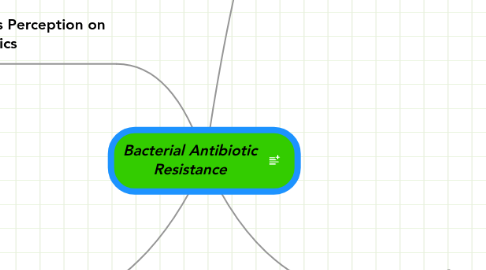
1. Patient's Perception on Antibiotics
1.1. McNulty, C., P. Boyle, T. Nichols, P. Clappison, and P. Davey. "The public's attitudes to and compliance with antibiotics." Journal of Antimicrobial Chemotherapy 60.1 (2007): 63-8. Oxford Journals. Web. 20 May 2010
1.1.1. What do antibiotics treat? Bacterial vs. Viral
1.1.1.1. Antibiotics ONLY treat bacteria infections.
1.1.2. Saving antibiotics for a "rainy day"
1.1.2.1. Most antibiotics break down into harmful substances when left on the shelf. (FIND SOURCE!)
1.1.2.2. Not taking a full course of antibiotics can cause the patient to be reinfected if not every single organism is killed.
1.2. Oppinion
1.2.1. We live in a quick fix society, where people want to fix their problems quickly.
1.2.2. Patient's often demand that an antibiotic treatment be given, even if antibiotics may not help.
1.2.2.1. IE: The cold, the cold is the rhinovirus, virii are not destroyed by antibiotics.
2. Physician's Perception on Antibiotics
2.1. Costelloe, C., C. Metcalfe, A. Lovering, D. Mant, and A. Hay. "Effect of antibiotic prescribing in primary care on antimicrobial resistance in individual patients: systematic review and meta-analysis."British Medical Journal 340.10 (2010): 1120. BMJ: Helping doctors make better decisions. Web. 20 May 2010.
2.1.1. Positive correlation between resistant type organisms and primary care physicans prescribing antibiotics.
2.2. Coco, A, M Horst, and A Gambler. "Trends in broad-spectrum antibiotic prescribing for children with acute otitis media in the United States, 1998–2004." BMC Pediatrics 9.41 (2009): n. pag. PubMed. Web. 19 May 2010.
2.2.1. Physician's are prescribing antibiotics for otitis media more frequently, even though the infection will go away without treatment.
2.3. Vlahović-Palčevski, V, M Morović, G Palčevski, and L Betica-Radić. "Antimicrobial Utilization and Bacterial Resistance at Three Different Hospitals ." European Journal of Epidemiology 17.4 (2001): 375-83. JSTOR. Web. 19 May 2010.
2.3.1. Hospitals that utilized antibiotics the most had higher rates of resistant organisms.
2.4. Oppinion
2.4.1. Are physicians prescribing more antibiotics to make patients more satisfied with their care?
2.4.1.1. If a patient does not get antibiotics from this physician, they can get it somewhere else.
2.4.2. Are physicians overwhelmed from seeing so many patients, so it is easier to prescribe a broad spectrum antibiotic vs. narrow?
3. Bacterial "Evolution"
3.1. Talaro, Kathleen Park. Foundations in Microbiology. New York: McGraw-Hill Science/Engineering/Math, 2008. Print.
3.1.1. Conjugation: requires two bacteria connected via a pilus
3.1.2. Transformation: DNA (from environment) is taken up be a cell and incorporated
3.1.3. Transduction: DNA is exchanged via a virus particle
3.2. Beta-lactamase
3.2.1. Allows bacteria to "eat" penicillin and thus, not be killed.
3.2.2. Exoenzyme spewed into the environment by bacteria.
4. Usage of Antibiotics
4.1. Costelloe, C., C. Metcalfe, A. Lovering, D. Mant, and A. Hay. "Effect of antibiotic prescribing in primary care on antimicrobial resistance in individual patients: systematic review and meta-analysis."British Medical Journal 340.10 (2010): 1120. BMJ: Helping doctors make better decisions. Web. 20 May 2010.
4.1.1. Resistant bacteria can evolve from patient's with respiratory or urinary tract infections 1-12 months after using antibiotics.
4.1.1.1. Antibiotic resistant organisms are now able to colonize otherwise healthy individuals.
4.1.1.2. Shenoy, M, G Bhat, A Kishore, and M Hassan. "Significance of MRSA strains in community associated skin and soft tissue infections." Indian Journal of Medical Microbiology 28.2 (2010): 152-54. Medknow. Web. 19 May 2010.
4.1.1.2.1. Community acquired MRSA
4.2. Broad Spectrum vs. Narrow Spectrm
4.2.1. Do broad spectrum antibiotics increase the occurence of resistance?
4.2.2. Broad spectrum are frequently used when a specific infection is unknown.
4.2.3. Narrow spectrum is given for specific infections and kills just that organism.
4.3. Coco, A, M Horst, and A Gambler. "Trends in broad-spectrum antibiotic prescribing for children with acute otitis media in the United States, 1998–2004." BMC Pediatrics 9.41 (2009): n. pag. PubMed. Web. 19 May 2010.
4.3.1. Antibiotic usage has increased from 34-45% since 1998.
